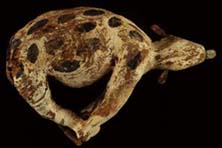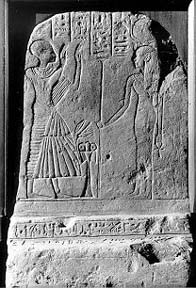A Taste of the Ancient World:
Pharonic Egypt
 |
Grain Mummy
KM 88802
3rd Intermediate Period - Saite (c. 1070 - 525 BC)
Egypt |
This "grain mummy" symbolizes the Egyptian optimism about life
after death. The Egyptians took grains of barley and let them sprout in
Nile mud. The germinated grain in the mud was then wrapped in linen bandages
and made into a miniature mummy, which was decorated to resemble Osiris
- Egyptian god of the dead and the first mummy. The resulting grain mummy
was then placed into a coffin and left in a tomb as an eternal symbol of
the regeneration after death that the deceased hoped to achieve. The coffin
lid represents a protective falcon-god.
This grain mummy also represents, however, a very real concern about
agricultural fertility. The possibility of crop failure was an ever present
danger in the ancient Mediterranean. As in poorer and less developed parts
of the world today, people then ran a very real risk of famine and starvation.

|
Figure of Bound Ox
KM 88759
Early Middle Kingdom (2040 - 1783 BC)
Egypt |
This figure is from a butchery scene, originally part of a type of 'daily
life model' often included in Egyptian tombs. The figures of these scenes
helped the dead to continue daily activities in the afterlife, and the butchered
ox was thought to help supply the deceased with sufficient food.
 |
Stela: Isis with Priest
KM 88806
19th Dynasty (1293 - 1185 BC)
Egypt |
Stelae, or carved reliefs, were intended to provide food to the deceased
for eternity. This stele features a priest (left), shaven and in ceremonial
dress, worshipping the goddess Isis. An offering table holding food stands
between them. The text on ths stele reads as a passage invoking this 'food'
for the deceased soul and the blessing of the gods upon it.
Go on to the Greco-Roman world.